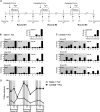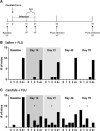Repeated vulvovaginal fungal infections cause persistent pain in a mouse model of vulvodynia
- PMID: 21937756
- PMCID: PMC3243907
- DOI: 10.1126/scitranslmed.3002613
Repeated vulvovaginal fungal infections cause persistent pain in a mouse model of vulvodynia
Abstract
Provoked vestibulodynia, the most common form of vulvodynia (unexplained pain of the vulva), is a prevalent, idiopathic pain disorder associated with a history of recurrent candidiasis (yeast infections). It is characterized by vulvar allodynia (painful hypersensitivity to touch) and hyperinnervation. We tested whether repeated, localized exposure of the vulva to a common fungal pathogen can lead to the development of chronic pain. A subset of female mice subjected to recurrent Candida albicans infection developed mechanical allodynia localized to the vulva. The mice with allodynia also exhibited hyperinnervation with peptidergic nociceptor and sympathetic fibers (as indicated by increased protein gene product 9.5, calcitonin gene-related peptide, and vesicular monoamine transporter 2 immunoreactivity in the vaginal epithelium). Long-lasting behavioral allodynia in a subset of mice was also observed after a single, extended Candida infection, as well as after repeated vulvar (but not hind paw) inflammation induced with zymosan, a mixture of fungal antigens. The hypersensitivity and hyperinnervation were both present at least 3 weeks after the resolution of infection and inflammation. Our data show that infection can cause persistent pain long after its resolution and that recurrent yeast infection replicates important features of human provoked vulvodynia in the mouse.
Figures




References
-
- Spiller R, Garsed K. Postinfectious irritable bowel syndrome. Gastroenterology. 2009;136:1979–1988. - PubMed
-
- Harlow BL, Stewart EG. A population-based assessment of chronic unexplained vulvar pain: Have we underestimated the prevalence of vulvodynia? J. Am. Med. Womens Assoc. 2003;58:82–88. - PubMed
-
- Goldstein AT, Burrows L. Vulvodynia. J. Sex. Med. 2008;5:5–14. - PubMed
-
- Meana M, Binik YM, Khalife S, Cohen DR. Biopsychosocial profile of women with dyspareunia. Obstet. Gynecol. 1997;90:583–589. - PubMed
-
- Pukall CF, Binik YM, Khalifé S, Amsel R, Abbott FV. Vestibular tactile and pain thresholds in women with vulvar vestibulitis syndrome. Pain. 2002;96:163–175. - PubMed
Publication types
MeSH terms
Substances
Grants and funding
LinkOut - more resources
Full Text Sources
Other Literature Sources
Medical

